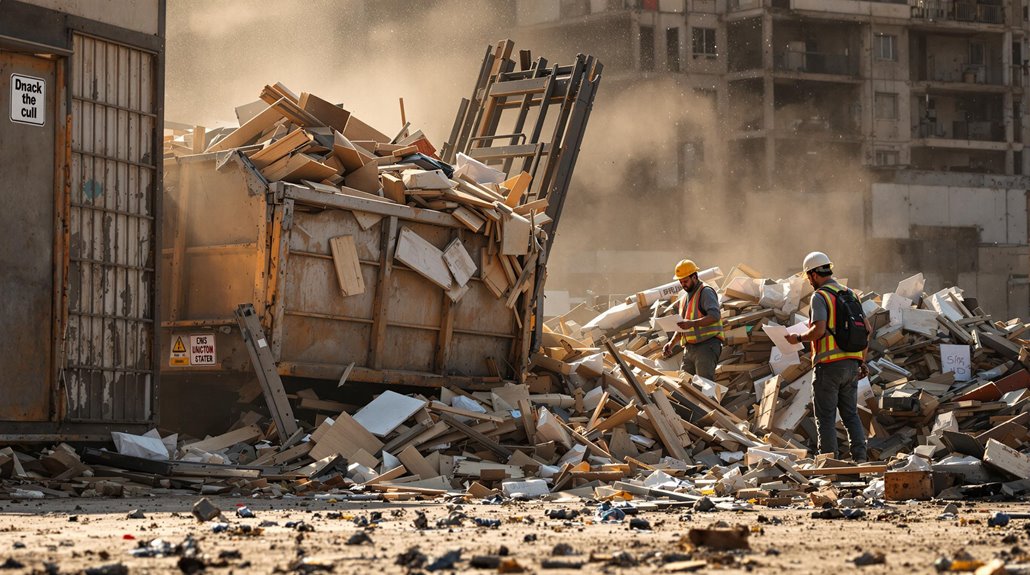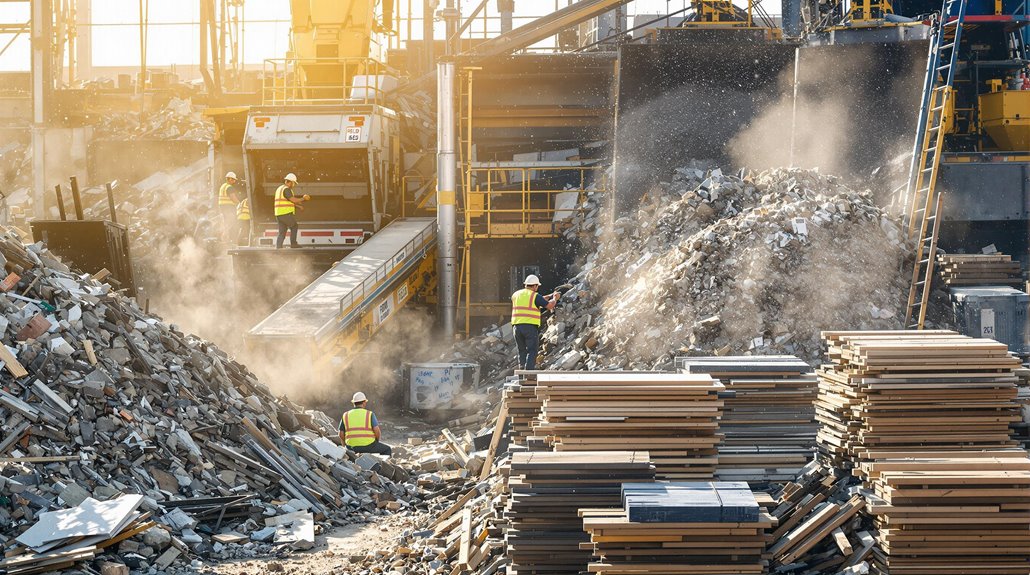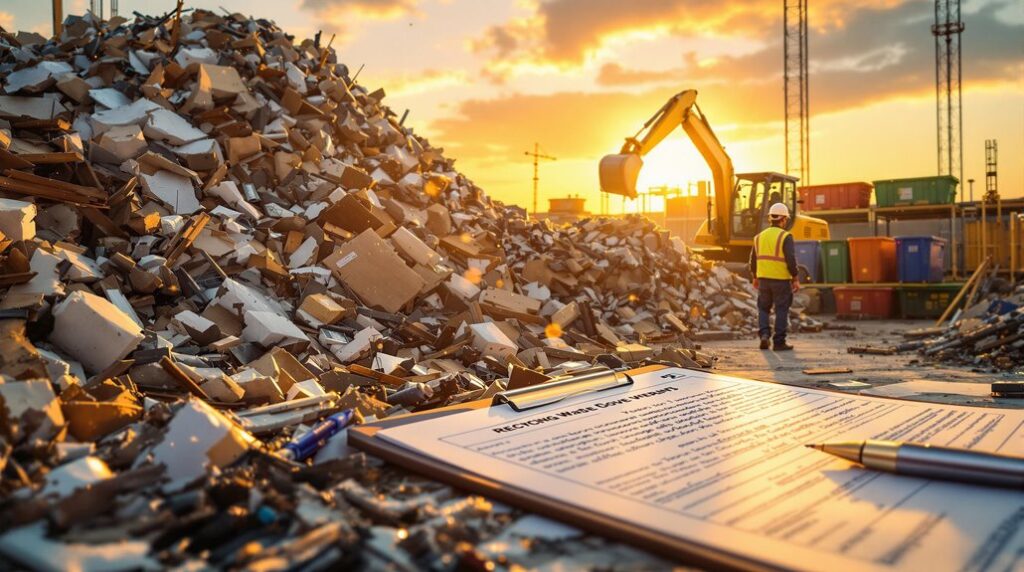Construction debris presents significant environmental challenges, generating over 600 million tons of waste annually. Effective management requires strategic planning: implementing daily removal routines, using labeled bins for different materials, and establishing on-site recycling stations. Choosing waste removal partners committed to environmental responsibility guarantees proper material recovery. Smart strategies include just-in-time delivery, contamination prevention through proper segregation, and maintaining relationships with recycling centers. The following practices transform this potential headache into a streamlined, sustainable process.
The Hidden Environmental Cost of Construction Waste

Mountains of debris rise behind construction sites across America, largely unseen by the public yet staggering in scale. The construction industry generates over 600 million tons of waste annually—more than twice the amount of municipal solid waste. This debris accounts for 10-30% of global landfill volume while the sector contributes 35% of worldwide CO2 emissions.
Behind these numbers lies a trail of environmental damage. Construction waste contaminates soil and water with chemicals and microplastics from paints and adhesives. Cement production and decomposing materials release greenhouse gases, while improper disposal threatens ecosystems and biodiversity. Despite these impacts, nearly all projects (95.71%) face waste challenges, yet barely half measure their waste volumes. The most concerning aspect remains concrete waste—representing 50% of demolition debris—with limited reuse options.
Smart Strategies for On-Site Waste Management
Addressing construction waste requires more than merely acknowledging the problem—it demands systematic approaches and intelligent management techniques. Successful projects now implement daily debris removal routines and strategically place labeled bins to separate recyclables, hazardous materials, and general waste.
On-site recycling stations create immediate opportunities to process materials such as concrete and metals, while digital solutions track waste generation in real-time. Many contractors are adopting lean construction principles and prefabricating components off-site to minimize cutting waste and assembly errors.
Worker training remains essential—when teams understand proper segregation protocols and tool usage, waste reduction improves dramatically. The most effective programs combine technological innovations with practical solutions such as just-in-time delivery and offcut reuse, creating thorough waste management systems that reduce environmental impact while improving project efficiency.
Material Recovery: Turning Debris Into Resources

While construction sites generate substantial waste, proper material recovery transforms this debris into valuable resources through systematic separation processes. High-value materials yield significant cost benefits, with scrap metal containers costing nothing to remove versus $650 for mixed loads. Pre-demolition salvage captures valuable fixtures such as sinks and ornate stonework before demolition begins.
Despite urban space constraints limiting on-site separation, processing facilities utilize advanced sorting technologies to recover usable materials. Deconstruction practices can achieve net savings compared to traditional demolition, as demonstrated in Port of Oakland projects where recoverable materials offset costs. Concrete becomes aggregate for new construction, while wood waste converts to mulch or engineered products. Contamination prevention remains essential, since mixing materials can render recyclables unusable and diminish their market value. Professional junk removal services streamline the cleanup process while ensuring materials are properly sorted and recycled.
Choosing the Right Waste Removal Partner for Your Project
Selecting an appropriate waste removal partner represents a critical decision that impacts both project efficiency and environmental outcomes. Contractors should evaluate potential partners based on their commitment to environmental responsibility, particularly their approach to recycling metals, wood, and concrete materials. Following eco-friendly disposal practices helps minimize negative impacts on the environment while maximizing resource recovery potential.
The ideal waste management company demonstrates transparent sorting processes and provides documentation of materials diverted from landfills. At the time of interviewing potential partners, ask specific questions about their recycling facilities, material recovery rates, and disposal methods. Companies that prioritize reuse and recycling often maintain relationships with local recycling centers and material recovery facilities.
Remember that the cheapest option rarely delivers the best environmental value. Look beyond the initial price quote to reflect on a partner’s complete waste management approach, including how they maximize resource recovery and minimize environmental impact.
Frequently Asked Questions
How Do I Assess Disposal Costs for My Specific Construction Project?
Calculate disposal costs by:
- Measure waste volume
- List material types
- Check local disposal rates
- Add transportation costs
- Subtract recycling credits
- Add hazardous material fees
Can C&D Waste Recycling Earn LEED Points for My Project?
C&D waste recycling earns LEED points by:
- Diverting minimum 50% of materials
- Segregating 3+ material streams
- Using certified recycling facilities
- Providing documentation
What Permits Are Required for Construction Waste Disposal?
Construction waste disposal requires:
- Federal hazardous waste permits
- State landfill permits
- Local hauling licenses
- Hazardous materials authorizations
- Operational contingency plans
- Financial compliance assurances
How Long Should I Store Debris On-Site Before Removal?
VSQGs: No time limit
SQGs: 180 days (270 if disposal site >200 miles away)
LQGs: 90 days
Which Construction Materials Contain Hazardous Substances Requiring Special Disposal?
Construction materials requiring special disposal: asbestos insulation, lead paint, mercury thermostats, CCA-treated timber, PCB-containing ballasts, materials with flame retardants, VOCs, and PFAS chemicals.
References
- https://www.bigrentz.com/blog/construction-waste-statistics
- http://miamibeachseniorhigh.net/wp-content/uploads/2023/06/Practical-Research-Planning-and-Design-Capstone-Research.pdf
- https://www.bts.gov/archive/subject_areas/freight_transportation/faf/faf4/debris
- https://letrunghieutvu.yolasite.com/resources/w-lawrence-neuman-social-research-methods_-qualitative-and-quantitative-approaches-pearson-education-limited-2013.pdf
- https://affordabledumpsterrentalservices.com/construction-waste-statistics/
- https://constructive-voices.com/understanding-the-impacts-of-waste-generated-from-construction/
- https://earth911.com/business-policy/construction-waste-deconstructing/
- https://pmc.ncbi.nlm.nih.gov/articles/PMC8971575/
- https://www.epa.gov/facts-and-figures-about-materials-waste-and-recycling/construction-and-demolition-debris-material
- https://www.weforum.org/stories/2024/02/construction-sustainable-building/

